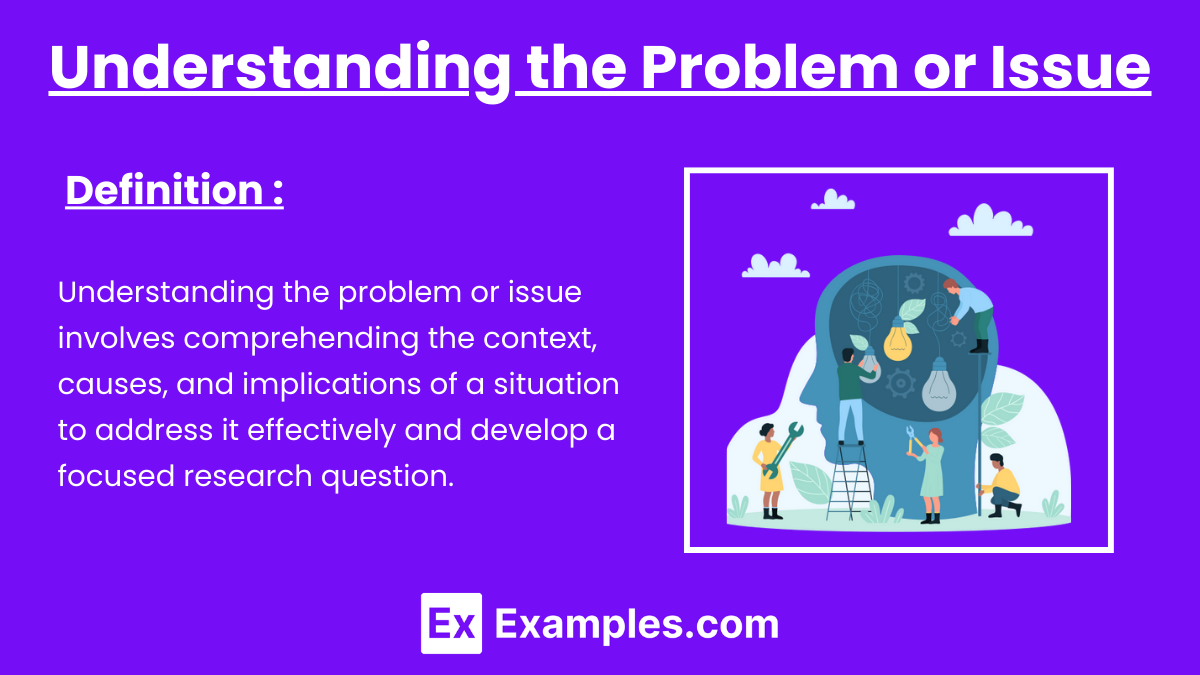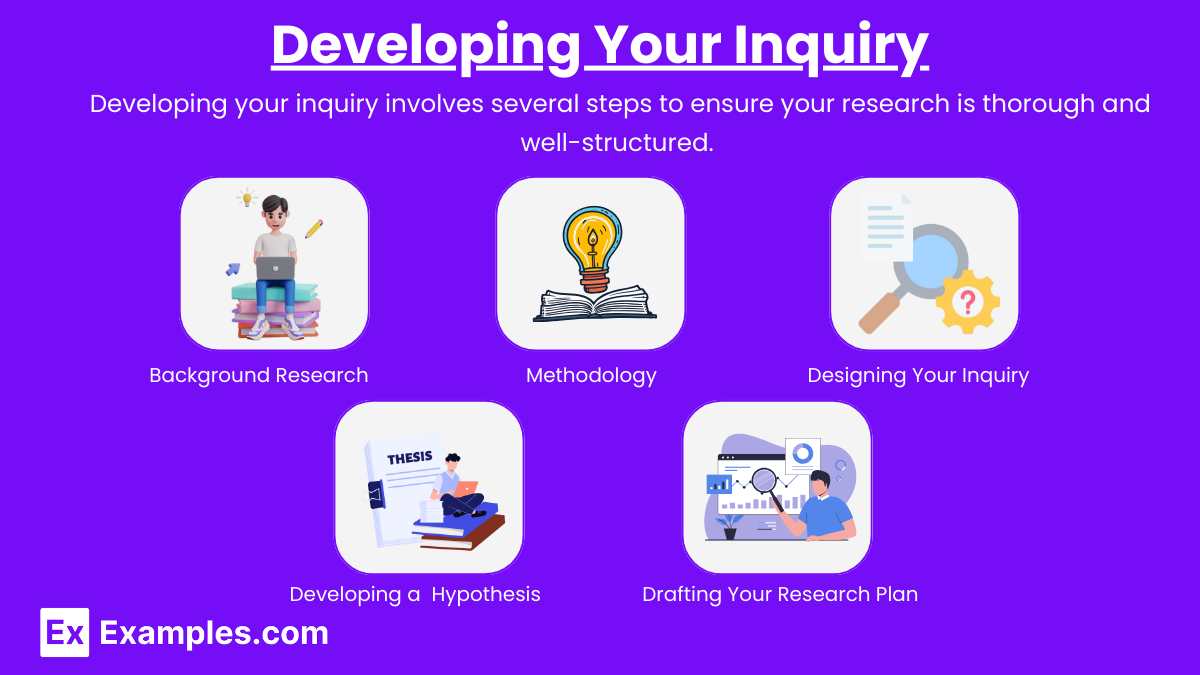Identifying a problem or issue and developing a research question is a crucial skill in academic inquiry, particularly in the AP Seminar course. In this process, students must first pinpoint a significant issue or problem within their area of interest, ensuring it is both relevant and researchable. Once a clear problem is identified, formulating a focused and open-ended research question becomes essential. This question should drive the investigation, guiding the collection and analysis of data to uncover new insights or solutions. Mastering these skills in AP Seminar not only enhances critical thinking but also prepares students for rigorous academic research.
Learning Objectives
Learn to identify and analyze significant problems or issues by conducting thorough background research and evaluating their relevance and impact. Develop skills to formulate clear, focused, and researchable questions that invite in-depth investigation and analysis. Understand how to explore various perspectives, assess scope and feasibility, and ensure your question addresses a complex, multifaceted issue that can be examined from multiple angles with available resources.
Understanding the Problem or Issue

1. Definition and Scope
- Problem Definition: Clearly articulate what the problem or issue is. This involves identifying the core of the problem and understanding its nature. For instance, if the issue is “climate change,” specify which aspect you are addressing, such as its impact on coastal communities.
- Scope: Determine the extent of the problem. Is it local, national, or global? For example, are you looking at the effects of climate change on a specific city or on entire coastal regions?
2. Context and Background
- Historical Context: Explore the background and history of the issue. Understanding the evolution of the problem helps in comprehending its current state. For instance, in studying plastic pollution, look into the history of plastic production and its environmental impact.
- Current Status: Investigate the current state of the problem. What are the latest developments or trends? This could involve reviewing recent research, policy changes, or public discourse related to the issue.
3. Relevance and Significance
- Impact: Assess the significance of the problem. Who is affected and how? Understanding the consequences or implications helps in justifying why the issue is worth investigating. For example, analyzing the impact of educational inequality on student outcomes highlights its importance for educational reform.
- Stakeholders: Identify the key stakeholders involved. These could include individuals, communities, organizations, or governments. Understanding their perspectives can provide a comprehensive view of the problem.
4. Research Gap and Justification
- Existing Research: Review existing literature to identify what is already known about the issue. This helps in pinpointing gaps in knowledge or areas that need further exploration. For example, if previous studies have not fully explored the effects of a specific environmental policy, this could be a gap to address.
- Justification: Explain why the problem is significant and worth studying. This involves presenting evidence or arguments that support the need for further investigation or intervention.
5. Formulating the Problem Statement
- Problem Statement: Develop a clear and concise problem statement that summarizes the issue. This statement should outline the problem’s core aspects and its importance, setting the stage for the development of a focused research question.
Developing a Research Question

Developing a research question is a critical step in academic research that sets the direction for your study. A well-formulated research question helps focus your inquiry, guides your methodology, and determines how you will analyze and interpret data. Here’s a detailed breakdown of how to develop a research question :
1. Identify a General Topic
Start with a broad area of interest related to your problem or issue. This could be based on your own curiosity, academic interests, or current events. For example, if you are interested in environmental science, your general topic might be “the impact of pollution on marine life.”
2. Narrow Down the Topic
Refine your broad topic to focus on a specific aspect or issue within it. This involves identifying a particular angle or subset of the general topic that is both manageable and significant. Continuing with the example above, you might narrow it down to “the effects of plastic pollution on coral reefs.”
3. Conduct Background Research
Before finalizing your research question, conduct preliminary research to understand what is already known about your narrowed topic. Review academic literature, reports, and other relevant sources to identify gaps in knowledge and current debates. This helps in framing a question that addresses an area of need or interest.
4. Formulate the Research Question
- Clarity: Ensure the question is specific and unambiguous. Avoid vague language and generalizations. For instance, instead of asking, “How does pollution affect marine life?” ask, “What are the effects of plastic pollution on the reproductive health of coral reef species in the Great Barrier Reef?”
- Focus: The question should be narrow enough to be answered within the scope of your research. A focused question allows for a more detailed and in-depth investigation.
- Researchable: Make sure the question can be addressed through available research methods and data. It should be possible to collect and analyze data to provide an answer.
- Open-Ended: The question should encourage exploration and discussion rather than a simple yes/no answer. It should prompt further investigation and analysis.
5. Refine and Revise
After formulating an initial question, review and refine it based on feedback and further research. Ensure it aligns with your research goals and objectives. Revise it if necessary to improve clarity, focus, and feasibility.
6. Examples of Research Questions
- Social Issue:
- “How does access to affordable housing impact the quality of life for low-income families in urban areas?”
- Explores the relationship between housing availability and the well-being of a specific demographic.
- Environmental Issue:
- “What are the long-term effects of deforestation on soil erosion in tropical rainforests?”
- Investigates the consequences of deforestation practices on soil health.
Types of Research Questions

- Descriptive: What is the current state of a phenomenon? (e.g., “What are the most common sources of plastic pollution in marine environments?”)
- Analytical: Why is something happening? (e.g., “Why are certain types of plastics more harmful to coral reefs than others?”)
- Evaluative: What are the effects or implications? (e.g., “What are the ecological consequences of plastic pollution on coral reef biodiversity?”)
- Comparative: How do different factors compare? (e.g., “How does the impact of plastic pollution on coral reefs differ between tropical and temperate regions?”)
Developing Your Inquiry

Developing your inquiry involves several steps to ensure your research is thorough and well-structured. Here’s a detailed breakdown of the process:
1. Background Research
- Literature Review:
- Purpose: To understand existing knowledge and identify research gaps.
- Process: Review academic articles, books, and credible sources related to your research question.
- Outcome: Summarize key theories, findings, and debates relevant to your topic.
- Contextual Understanding:
- Purpose: To grasp the broader context of your research question.
- Process: Explore historical, cultural, or situational factors that influence your topic.
- Outcome: Provide a backdrop that helps frame your research question within a larger context.
2. Methodology
- Approach:
- Qualitative: Involves non-numerical data, such as interviews, observations, or content analysis.
- Use: Best for exploring complex phenomena, understanding perspectives, and generating in-depth insights.
- Quantitative: Involves numerical data, such as surveys, experiments, or statistical analysis.
- Use: Best for measuring variables, testing hypotheses, and identifying patterns.
- Qualitative: Involves non-numerical data, such as interviews, observations, or content analysis.
- Data Collection:
- Sources: Determine where and how you will gather data. This could include surveys, experiments, archival research, or interviews.
- Tools: Use appropriate tools and instruments for data collection, such as questionnaires, data logs, or interview guides.
- Data Analysis:
- Techniques: Select methods for analyzing your data. This could include statistical analysis, thematic coding, or comparative analysis.
- Outcome: Interpret the data to answer your research question, drawing conclusions based on your findings.
3. Developing a Thesis or Hypothesis
- Thesis Statement:
- Purpose: To provide a clear and concise summary of your main argument or position based on your research question.
- Formulation: Based on your research findings, develop a statement that outlines the central point or argument of your study.
- Example: “The increasing use of renewable energy sources significantly reduces greenhouse gas emissions and mitigates the impact of climate change on coastal ecosystems.”
- Hypothesis (if applicable):
- Purpose: To propose a testable statement that predicts the relationship between variables.
- Formulation: Create a hypothesis based on your research question and background research.
- Example: “If the implementation of stricter pollution controls is enforced, then the incidence of respiratory diseases in urban areas will decrease.”
4. Designing Your Inquiry
- Research Design:
- Structure: Outline the overall structure of your research, including the methods and procedures you will use.
- Timeline: Develop a timeline for each phase of your research, from data collection to analysis and writing.
- Ethical Considerations:
- Approval: Ensure your research design complies with ethical standards and obtain necessary approvals if required.
- Informed Consent: If applicable, obtain consent from participants and ensure their rights and privacy are protected.
5. Drafting Your Research Plan
- Outline: Create a detailed research plan that includes your research question, methodology, data collection methods, and analysis techniques.
- Proposal: Write a research proposal if needed, summarizing your research question, objectives, and methodology. This is often required for formal research projects.


